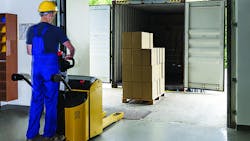Material Handling: The Secret to Reducing Workplace Injuries and Expenses
There are many, somewhat exotic hazards in workplaces, and these can lead to unique, attention-grabbing and even horrifying injuries.
By contrast, manual material handling can seem somewhat humdrum, and the work-related musculoskeletal disorders it causes can be easy to overlook. But overlook this hazard at your peril and at the peril of your employees as well.
Work-related musculoskeletal disorder (WMSD) claims related to overexertion and repetitive motion injuries serious enough to result in time off work or disability benefits accounted for 21 percent of total state-funded claims from 2009-2013, according to Ninica Howard, an occupational health and safety researcher with the SHARP research group.
That’s a little more than one in every five claims during a five-year period, which should be more than enough to catch your attention.
Let’s look at those claims in a little more detail:
• Injuries to the back, neck and shoulders account for about 2/3 of manual material handling claims.
• The most commonly cited cause of injury was handling a container (25 percent).
• Among WMSD claims where the injury type was
specified,
–55 percent were attributed to lifting,
–17 percent were attributed to holding, carrying, turning and wielding,
– 14 percent were attributed to pushing and pulling
If you want to reduce workplace injuries in general, the low- hanging fruit is with musculoskeletal disorders (MSDs) affecting the back, neck and shoulders that are caused by lifting.
“Lifting is by far the biggest issue when it comes to WMSDs or ‘sprains and strains’ in the workplace. There are two lifting problem areas. Heavy lifting is the obvious risk. And awkward lifts – bending over, reaching out or reaching up to lift objects – are the second biggest problem, even if this is less obvious,” said Rick Goggins, an ergonomist with Washington State Department of Labor and Industries (DOSH).
Can you use training to fix this problem? Goggins doesn’t think so, at least not by relying on training alone.
“There’s been a lot of focus in industry on safe lifting and body mechanics training, but by itself that training hasn’t been effective at preventing injuries,” he said.
To explain his view, Goggins points to physical therapists.
“They’re likely one of the most knowledgeable groups when it comes to body mechanics, yet they have high rates of back injuries when they lift as part of their jobs. This is especially true in health care, where they lift patients, which is one of the heaviest and most awkward lifts we typically ask people to do manually on the job.”
So what can employers do to reduce injuries from these kinds of lifts?
“There seems to be a tendency to store heavy things on the floor, but that’s a really bad location if someone’s later going to have to manually lift something. We’d have fewer problems if these heavy items were stored around waist level. I think we’d see a sizable decrease in lifting-related injuries.”
He said that engineering solutions, such as replacing manual material handling with equipment, can be more effective. However, such solutions often fail if not implemented correctly. That’s why he recommends that workers should at the least receive training if such equipment is installed.
U.S. Companies Pay $62 Billion Per Year for Workplace Injuries
“An even-better approach is to create a thorough ergonomics process that involves employees in finding hazards and development solutions to control them. This can help to overcome resistance to change. As a bonus, it often results in a more cost-effective solution,” Goggins said.
Lifting Tips
“One last tendency that might be partially to blame for the continued prevalence of lifting injuries is an over-reliance on ineffective solutions. For example, we still occasionally get questions about back belts for lifting, despite a lack of evidence that they prevent injuries,” Goggins said.
Howard encourages awareness when lifting anything.
“Employers and employees may pay close attention to how heavy objects are lifted, however, there should also be equal mindfulness when lifting lighter loads – those small “insignificant” loads that are handled every day, throughout the day. Over time, these loads can contribute to injuries the same as heavier loads,” Howard said.
So what do you think? What are some of the best ways to reduce the number and expenses of work-related injuries? Do you agree that manual material handling is a good place to look, or would you point to something else? And if you agree with manual material handling, what steps would you suggest to reduce these injuries?
Jeff Dalto is the customer education specialist at Convergence Training, a company that provides safety training solutions and other training solutions for industrial and manufacturing companies. Dalto has worked in education/training for more than 20 years and in safety training for more than 10. He also writes the Convergence Training blog, where you can find helpful articles on topics related to safety, training and more.
About the Author
Jeff Dalto
Customer Education Specialist
Jeff Dalto is the customer education specialist at Convergence Training, a company that provides safety training solutions and other training solutions for industrial and manufacturing companies. Jeff has worked in education/training for more than twenty years and in safety training for more than ten. He also writes the Convergence Training blog, where you can find helpful articles on topics related to safety, training and more.
